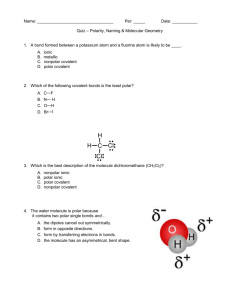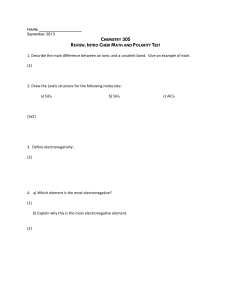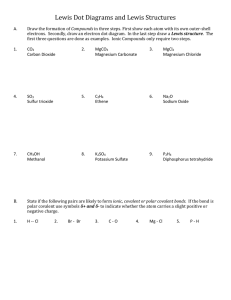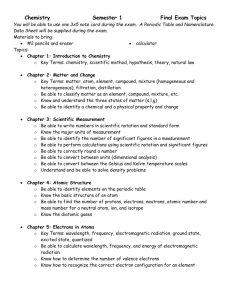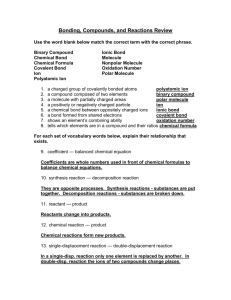Intermolecular and Intramolecular Forces Review
advertisement
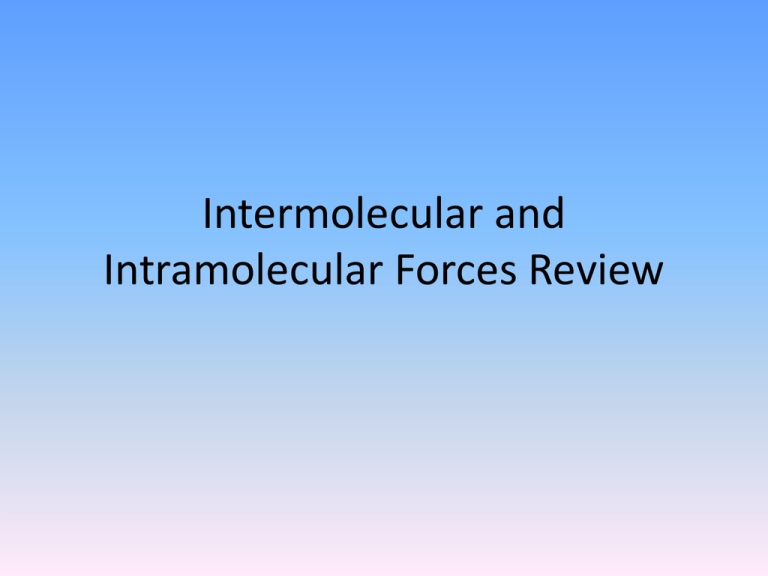
Intermolecular and Intramolecular Forces Review In the compound PCl3, how many valence electrons are present? 4 8 24 26 0% 26 0% 24 0% 8 0% 4 1. 2. 3. 4. How many valence electrons are available in the ion NO3 ? 16 9 22 24 0% 24 0% 22 0% 9 0% 16 1. 2. 3. 4. Which type of bond has an electronegativity difference greater than 1.8? ionic metallic nonpolar covalent polar covalent no np o co va le nt 0% ar lar m co v et al ale nt lic 0% po l 0% c 0% io ni 1. 2. 3. 4. What molecular shape is the compound CCl4? trigonal planar tetrahedral octahedral bent 0% be nt ah ed ra l 0% oc t ah ed ra l 0% te tr al p lan ar 0% tri go n 1. 2. 3. 4. How many bond pairs of electrons exist in a molecule of ammonia (NH )? 3 1. 1 2. 2 3. 3 4. 4 0% 4 0% 3 0% 2 1 0% What molecular shape is the compound NH3? trigonal planar tetrahedral trigonal pyramidal bent 0% be nt yr a m ... 0% al p tri go n ah ed ra l 0% te tr al p lan a. .. 0% tri go n 1. 2. 3. 4. If the electronegativity of H is 2.20 and of Cl is 3.55, which type of bond is formed between H and Cl, when they form hydrogen chloride? 1. Ionic 2. Polar ionic 3. Covalent 4. Polar covalent 0% Po l ar co va le nt en t 0% Co va l ar io ni c 0% Po l Io ni c 0% Which of the following is a polar molecule? CO2 Br2 BCl 3 NH3 CH4 0% CH 4 0% NH 3 0% BC l3 0% Br 2 0% CO 2 1. 2. 3. 4. 5. Which of the following is a nonpolar molecule? CF4 H2O NCl 3 NH3 NO30% NO 3- 0% NH 3 3 0% NC l 0% H2 O 0% CF 4 1. 2. 3. 4. 5. Which is a typical characteristic of an ionic compound? 0% ha s.. d. .. po un d om io ni cc io ni Th e cc om po un d po un d om cc io ni 0% is ha s. .. sh ar e ar irs pa Th e ro n Ele ct 0% .. 0% Th e 1. Electron pairs are shared among atoms. 2. The ionic compound has a low solubility in water. 3. The ionic compound is described as a molecule. 4. The ionic compound has a high melting point. Why do atoms share electrons in covalent bonds? 0% 0% cr ea s et he ir a to m i.. . po la m or e in to be co m e ega s no bl a n ta i at to el e. .. a. . at tr nd ns a io e be co m to 0% r 0% to 1. to become ions and attract each other 2. to attain a noble-gas electron configuration 3. to become more polar 4. to increase their atomic numbers en 0% ni tro g in e 0% flu or 0% ox yg en bo n 0% ca r 1. 2. 3. 4. Which of the following elements can form diatomic molecules held together by triple covalent bonds? carbon oxygen fluorine nitrogen The shape of the methane molecule CH4 is called ____. tetrahedral square four-cornered planar na r rn er ed -co fo ur 0% pl a 0% e 0% sq ua r ah ed ra l 0% te tr 1. 2. 3. 4. What causes water molecules to have a bent shape, according to VSEPR theory? 0% of n us ua l lo c at io an d ac t io n un ttr ca io ni 0% t.. re p. .. th e. .. 0% be tw ee n t io n in te ra c re pu lsi ve fo rc es b et w ee . .. 0% th e 1. repulsive forces between unshared pairs of electrons 2. interaction between the fixed orbitals of the unshared pairs of oxygen 3. ionic attraction and repulsion 4. the unusual location of the free electrons When placed between oppositely charged metal plates, the region of a water molecule attracted to the negative plate is the ____. 0% re gio n of th H em pl o. .. a. . 0% O& #8 21 2; he .. . 0% H& #8 21 2; en te ro ft cc et ri ge om hy dr o ge n re gi on of th e ... 0% ox yg en 1. hydrogen region of the molecule 2. geometric center of the molecule 3. H—O—H plane of the molecule 4. oxygen region of the molecule What is thought to cause the dispersion forces? 0% n el ec tr n on e. .. pa ir s 0% go fe le ct ro of el ec tro ns 0% sh ar in m ot io n at tra ct io n be tw ee n io ns 0% di ffe re nc es i 1. attraction between ions 2. motion of electrons 3. sharing of electron pairs 4. differences in electronegativity Which of the forces of molecular attraction is the weakest? dipole interaction dispersion hydrogen bond single covalent bond nd ale nt bo sin gle co v ge n di sp er sio 0% bo nd 0% n 0% hy dr o ol e in te ra ct io n 0% di p 1. 2. 3. 4. What causes dipole interactions? va l io ns 0% ee n ct io n co of a ng bo nd i be tw en tly po l ee n be tw 0% ... .. 0% n ct io at tra sh ar in go fe le ct ro n pa ir s 0% at tra 1. sharing of electron pairs 2. attraction between polar molecules 3. bonding of a covalently bonded hydrogen to an unshared electron pair 4. attraction between ions
